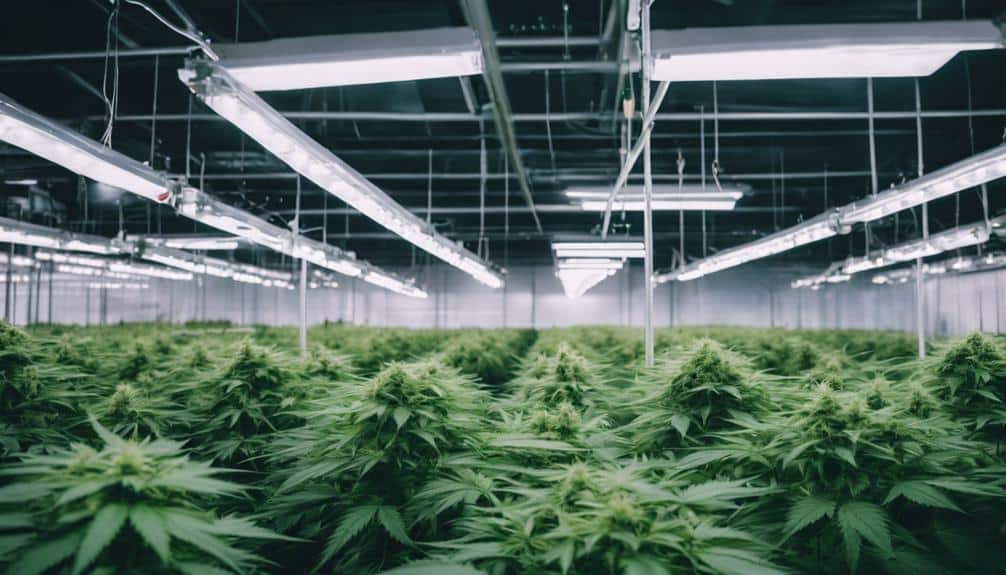Did you know that Delaware’s medical marijuana industry has begun to employ advanced hydroponic systems to enhance efficiency and plant health? These innovative techniques, which also encompass advanced LED lighting and organic soil amendments, are revolutionizing the way cannabis is grown. Have you ever pondered how integrated pest management and sustainable water usage practices influence the quality and sustainability of your medical marijuana? There’s a lot happening behind the scenes that’s worth exploring to comprehend how these methods contribute to superior, more reliable medicinal cannabis.
Table of Contents
Hydroponics Systems

Hydroponics systems provide precise control over nutrient delivery and environmental conditions, making them a favored method for cultivating high-quality medical marijuana in Delaware. By employing hydroponic techniques, you can meticulously manage nutrient solutions, ensuring that plants receive ideal concentrations of essential minerals. This precision contributes to achieving consistent and superior medicinal quality, which is crucial for patient care.
Root aeration is another significant factor in hydroponics that deserves attention. Proper aeration enhances oxygen availability at the root zone, promoting vigorous root growth and overall plant health. This is important because well-aerated roots can absorb nutrients more efficiently, directly impacting the potency and efficacy of the medical marijuana.
In a hydroponic setup, you also benefit from a controlled environment that minimizes risks of pests and diseases. This ensures that the produced medical marijuana is free from contaminants, aligning with stringent quality standards required for medical use.
Advanced LED Lighting
Incorporating advanced LED lighting into your cultivation setup can significantly optimize the growth cycles and cannabinoid profiles of medical marijuana plants in Delaware. By leveraging spectrum optimization, modern LED systems allow you to fine-tune light wavelengths, directly influencing photosynthesis and cannabinoid synthesis. This precision enables you to target specific growth stages, from vegetative to flowering, ensuring robust plant health and maximizing therapeutic compound production.
Energy efficiency is another substantial advantage of advanced LED lighting. Compared to traditional HID lights, LEDs consume considerably less power while providing equivalent or superior light output. This reduction in energy consumption not only lowers operational costs but also aligns with sustainable cultivation practices, which are essential for a medical marijuana facility dedicated to serving patients.
Moreover, LEDs generate less heat, reducing the need for extensive cooling systems. This can prevent heat stress in plants, further optimizing growth conditions and ensuring consistent quality.
Organic Soil Amendments

While optimizing lighting is crucial for healthy plant development, selecting the right organic soil amendments can further enhance the nutrient profile and microbial activity essential for medical marijuana cultivation in Delaware.
To boost your crop’s health and potency, you’ll need to incorporate specific amendments that enrich the soil and support robust plant growth.
Key organic soil amendments include:
- Compost Tea: A liquid solution derived from compost, rich in beneficial microorganisms and nutrients. It improves soil structure, boosts microbial activity, and enhances nutrient uptake.
- Worm Castings: Also known as vermicompost, these castings are the byproduct of earthworms digesting organic matter. They provide a rich source of nitrogen, phosphorus, and potassium, essential for healthy plant development.
- Bat Guano: High in nitrogen and phosphorus, bat guano is an excellent amendment for stimulating root growth and enhancing flower production.
- Bone Meal: A slow-release fertilizer that provides a steady supply of phosphorus, essential for root development and blooming phases.
Integrated Pest Management
Effectively managing pests in medical marijuana cultivation involves implementing an Integrated Pest Management (IPM) strategy that combines biological controls, cultural practices, mechanical methods, and chemical treatments to minimize pest damage and maintain plant health. By adopting IPM strategies you’ll not only reduce reliance on synthetic pesticides but also promote a sustainable ecosystem within your cultivation environment.
Start with biological controls such as beneficial insects like ladybugs and predatory mites which naturally keep pest populations in check. Companion planting is another effective cultural practice; plants like basil or marigold can repel harmful insects while attracting beneficial ones. These plants act as natural deterrents reducing the pest pressure on your marijuana crops.
Incorporate mechanical methods like sticky traps and physical barriers to prevent pest access. Regular monitoring coupled with early detection are critical; these methods allow you to act swiftly before infestations become severe.
If chemical treatments are necessary opt for organic or less toxic options to minimize environmental impact while ensuring patient safety.
Sustainable Water Usage

Implementing a sustainable water usage strategy is essential in medical marijuana cultivation, ensuring peak plant health while conserving resources. To achieve this, you must employ techniques that optimize water usage and reduce waste.
Implementing rainwater harvesting and drip irrigation systems can greatly improve water efficiency and sustainability in your operations. Rainwater harvesting involves collecting and storing rainwater for later use, offering a renewable water source that can reduce dependency on municipal supplies. By capturing rainwater, you can guarantee a consistent water supply even during dry periods.
Drip irrigation, on the other hand, delivers water directly to the plant roots minimizing evaporation and runoff. This method ensures that your plants receive the exact amount of water they need reducing overall water consumption.
Here’s why these techniques are vital:
- Resource Conservation: Reduce your reliance on local water supplies preserving them for the community.
- Efficiency: Drip irrigation ensures efficient use of water leading to healthier plants and higher yields.
- Cost Savings: Lower your utility bills by using rainwater and optimizing irrigation.
- Environmental Impact: Decrease your cultivation’s environmental footprint by using sustainable practices.
The adoption of these strategies not only benefits your cultivation process but also contributes positively to the environment and community at large.
In Conclusion
Imagine your plants thriving like a finely-tuned orchestra, each component playing its part harmoniously. Through hydroponics, advanced LED lighting, and organic soil amendments, Delaware cultivators hit all the right notes. Integrated pest management acts as the vigilant conductor while sustainable water usage ensures every drop is a purposeful beat.
By embracing these techniques, you’re not just growing cannabis; you’re orchestrating a symphony of precision and sustainability yielding high-quality medicine with environmental responsibility.
If you’re as excited about these innovative techniques as we are why not learn more? Visit Cannabis Docs of Delaware or give us a call at (855) 420-6797. We’re always here to help and share our passion for sustainable high-quality cannabis cultivation.

